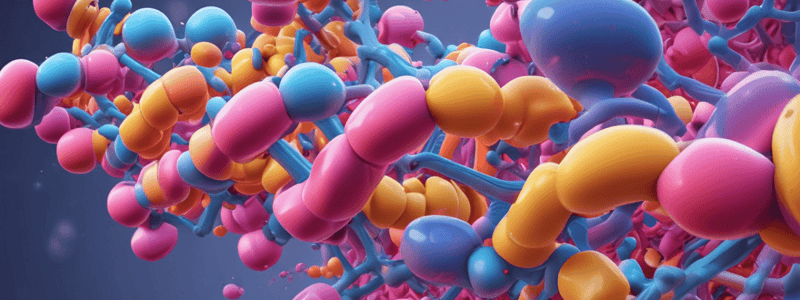Podcast
Questions and Answers
The F1 component of the ATP synthase enzyme has 3 β subunits with each adopting a different ______ at a given time (loose, open, and tight conformations).
The F1 component of the ATP synthase enzyme has 3 β subunits with each adopting a different ______ at a given time (loose, open, and tight conformations).
conformation
The hydrophobic effect stabilizes ______ structure.
The hydrophobic effect stabilizes ______ structure.
protein
Aromatic R Groups can contribute to the ______ effect.
Aromatic R Groups can contribute to the ______ effect.
hydrophobic
Cys can form ______ bonds.
Cys can form ______ bonds.
Cys has a positive hydropathy index, classified as polar due to its SH group's ability to act as a weak acid and be involved in weak ______ bonds.
Cys has a positive hydropathy index, classified as polar due to its SH group's ability to act as a weak acid and be involved in weak ______ bonds.
Amphitropic Proteins have a reversible lipid attachment process, where the lipid attachment is __________
Amphitropic Proteins have a reversible lipid attachment process, where the lipid attachment is __________
B-strands never occur singly, but always as part of a ________
B-strands never occur singly, but always as part of a ________
In a b-strand, each residue extends ________ Å
In a b-strand, each residue extends ________ Å
β-barrel proteins have no unpaired hydrogen bonding main chain groups, making them suitable as __________ proteins
β-barrel proteins have no unpaired hydrogen bonding main chain groups, making them suitable as __________ proteins
All b-barrel membrane proteins have an even number of b-strands, reflecting the requirement that they be inserted ________
All b-barrel membrane proteins have an even number of b-strands, reflecting the requirement that they be inserted ________
Since side chains in a beta strand project alternately on either side, all hydrophobic residues fall on one side and the hydrophilic residues fall on the other side of the ________ strand
Since side chains in a beta strand project alternately on either side, all hydrophobic residues fall on one side and the hydrophilic residues fall on the other side of the ________ strand
The hydrophobic side faces the __________ and the hydrophilic side faces the interior of the barrel.
The hydrophobic side faces the __________ and the hydrophilic side faces the interior of the barrel.
Even number of strands in OMP structures results in strands that do not ______ each other.
Even number of strands in OMP structures results in strands that do not ______ each other.
Periplasmic loops in OMP structures are often very ______, sometimes forming β-turns.
Periplasmic loops in OMP structures are often very ______, sometimes forming β-turns.
Barrels with 8-10 strands in OMP structures have a solid core filled with ______ residues.
Barrels with 8-10 strands in OMP structures have a solid core filled with ______ residues.
Intermediate-sized b-barrels with 16-18 strands in OMP structures have aqueous pores generally with inserted ______.
Intermediate-sized b-barrels with 16-18 strands in OMP structures have aqueous pores generally with inserted ______.
Large barrels with 22–26 b-strands in OMP structures generally have a plug domain that ______ into and closes most of the channel.
Large barrels with 22–26 b-strands in OMP structures generally have a plug domain that ______ into and closes most of the channel.
Match the OMP structure characteristics with their corresponding descriptions:
Match the OMP structure characteristics with their corresponding descriptions:
Match the OMP examples with their respective number of beta strands:
Match the OMP examples with their respective number of beta strands:
Match the OMP structure sizes with their corresponding features:
Match the OMP structure sizes with their corresponding features:
Match the location descriptions to the corresponding termini in OMP structures:
Match the location descriptions to the corresponding termini in OMP structures:
Match the residue types to their location in the beta-barrel structure:
Match the residue types to their location in the beta-barrel structure:
Match the amino acid property with its corresponding description:
Match the amino acid property with its corresponding description:
Match the protein symmetry with its example:
Match the protein symmetry with its example:
Match the number of beta strands with the corresponding OMP structure size:
Match the number of beta strands with the corresponding OMP structure size:
Match the location in a beta strand with its characteristic feature:
Match the location in a beta strand with its characteristic feature:
Match the residue type with its specific location in a beta-barrel structure:
Match the residue type with its specific location in a beta-barrel structure:
Match the effect with its role in stabilizing protein structure:
Match the effect with its role in stabilizing protein structure:
Match the amino acid classification with its rationale:
Match the amino acid classification with its rationale:
Match the termini description with its corresponding location in OMP structures:
Match the termini description with its corresponding location in OMP structures:
Match the number of subunits with their conformations in a protein complex:
Match the number of subunits with their conformations in a protein complex:
Match the lipid attachment process with its characteristic for Amphitropic Proteins:
Match the lipid attachment process with its characteristic for Amphitropic Proteins:
Match the following terms related to protein structure with their corresponding descriptions:
Match the following terms related to protein structure with their corresponding descriptions:
Match the following characteristics of VDAC (Voltage-Dependent Anion Channel) with their functions:
Match the following characteristics of VDAC (Voltage-Dependent Anion Channel) with their functions:
Match the residue types with their specific locations in beta-barrel structures:
Match the residue types with their specific locations in beta-barrel structures:
Match the following amino acid properties with their corresponding descriptions:
Match the following amino acid properties with their corresponding descriptions:
Flashcards are hidden until you start studying



